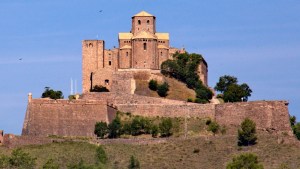In the heart of the La Garrotxa Volcanic Zone Natural Park in Girona (Spain), one finds the Santa Margarida volcano. Unexpectedly, though, this perfect volcanic cone brings together the awe-inspiring power of nature and the enduring spirit of faith: a serene, ancient hermitage sits right at the center of its crater.
The Garrotxa Volcanic Zone is a region shaped by eruptions that began 700,000 years ago and ceased about 8,000 years ago. It is home to a remarkable collection of volcanic cones, each cloaked in lush vegetation.
Among these, the Santa Margarida volcano is particularly striking – mainly because of its perfectly symmetrical shape.
The history of the Santa Margarida volcano is one of both geological drama and quiet reverence. The last major eruption occurred around 11,000 years ago, resulting in a powerful phreatomagmatic explosion that formed the wide crater we see today. Over the millennia, the volcanic cone has been covered by a dense forest, with remnants of lava flows and pyroclastic materials still visible along the Mas el Cros path, an alternative route that offers a deeper look into the volcanic landscape.

The hermitage at the center of the crater is a modest yet significant structure – a classic example of sober Catalan Romanesque style. Originally built in the 12th century, the hermitage has undergone several reconstructions, most notably in 1865, following its complete destruction in a series of 15th-century earthquakes.
The reason it was built in this place, according to Els Goigs a Llaor de la Santa (traditional Catalan “rhymes (or hymns) in honor of the saint”) was the seemingly miraculous discovery of the image of St. Margaret in the crater itself.
The image, made of alabaster, withstood the earthquakes of the 15th century. Today, visitors find a perfect replica of a 14th- or 15th-century sculpture of Santa Margarida (Saint Margaret) inside the hermitage – the original being housed in the Museo Diocesano de Girona.
Access to the Santa Margarida volcano is easy. A parking area nearby allows visitors to take a short, scenic hike to the crater, where the hermitage awaits. The climb takes approximately 30 minutes and is accessible to all. It offers stunning views – especially during autumn, when the forest canopy bursts into vibrant colors.
For those with a deeper interest in geology or a desire to extend their visit, the Garrotxa Natural Park also provides a 12-kilometer loop that includes the enchanting La Fageda d’en Jordà forest, and the imposing Croscat volcano, the largest in the Iberian Peninsula. This route highlights the region’s geological diversity, medieval charm, religious meaning, and natural beauty.



